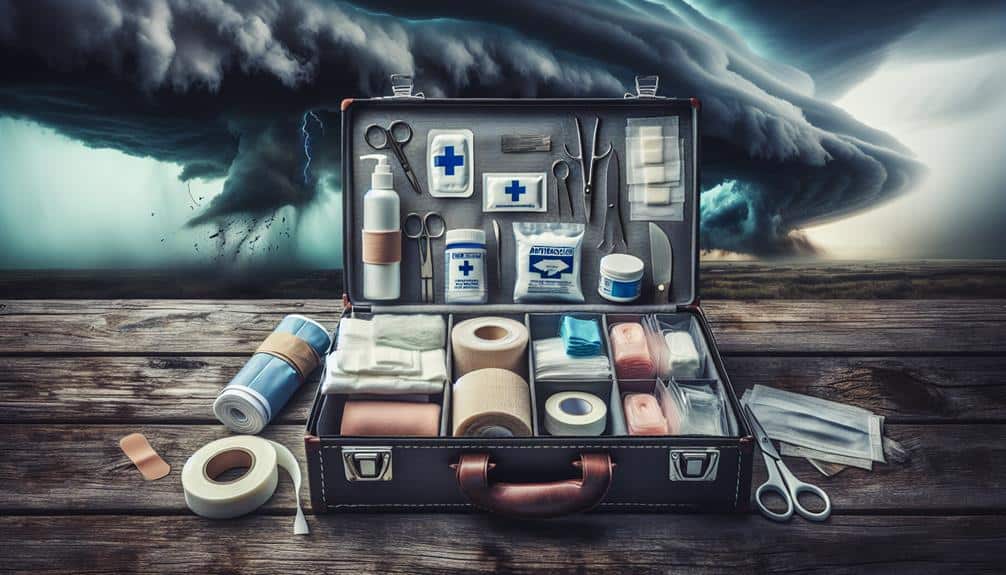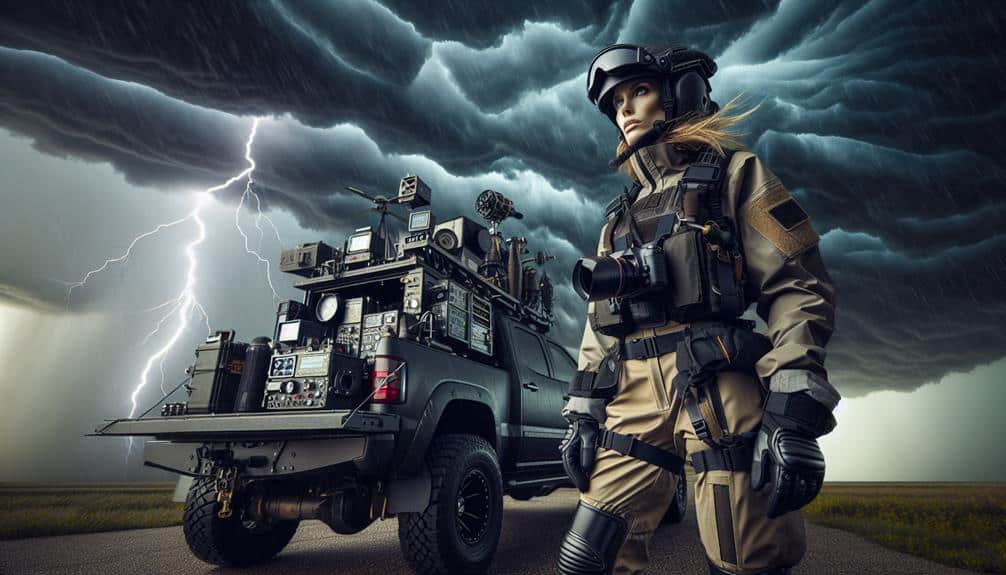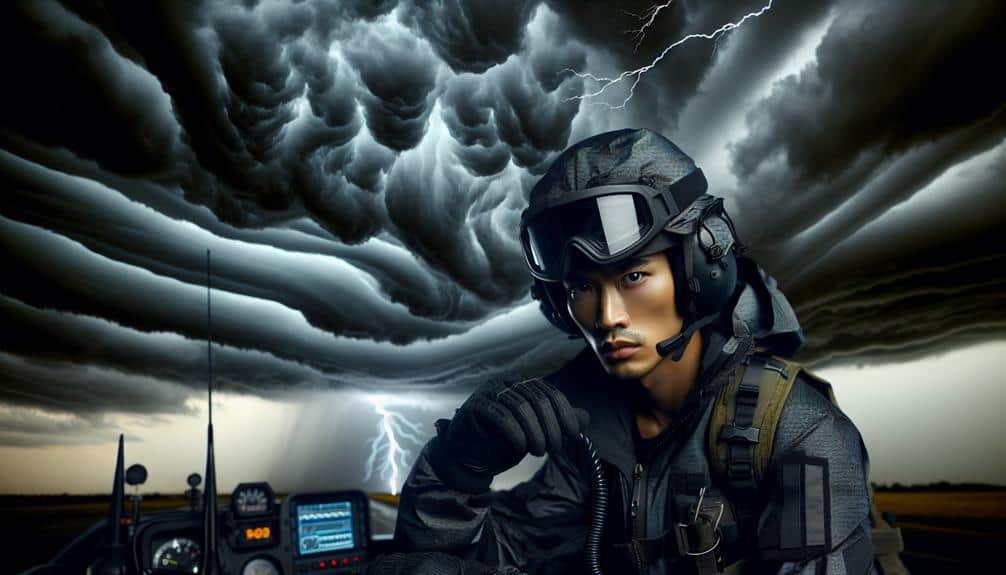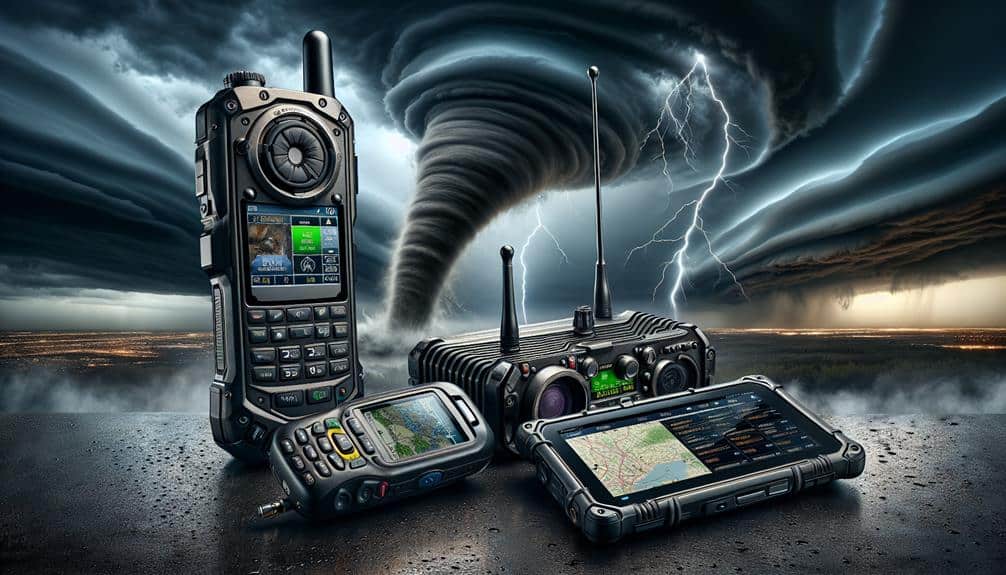When storm chasing, we must prioritize weather-resistant clothing with effective layering to stay dry and warm. Reliable communication devices, such as satellite phones and GPS trackers, ensure we stay connected in remote areas. Sturdy footwear like the Salomon Quest 4D 3 GTX provides essential support and traction on slippery terrain. Protective headgear, particularly high-impact-resistant helmets with shock-absorbing padding, is vital for safety. Lastly, a well-stocked first aid kit with essential medical supplies and tools can address common injuries. By understanding the importance of each gear item, we'll maximize our safety and preparedness during storm chasing.
Key Points
- Wear weather-resistant clothing with moisture-wicking, insulating, and waterproof layers for protection against harsh weather conditions.
- Use satellite phones and emergency beacons for reliable communication and distress signaling in remote areas.
- Opt for sturdy footwear like Salomon Quest 4D 3 GTX for excellent toughness, support, and traction.
- Choose high-impact-resistant helmets with shock-absorbing padding, adjustable straps, and integrated visors for head and eye protection.
Weather-Resistant Clothing
When storm chasing, we need to prioritize weather-resistant attire to ensure our safety and comfort in unpredictable conditions. The first step in achieving this is selecting garments that offer effective layering choices.
Layering allows us to adjust our clothing based on fluctuating temperatures and varying humidity levels. A base layer with moisture-wicking properties is essential to keep us dry, while an insulating middle layer retains body heat. The outer layer must be both waterproof and windproof, shielding us from harsh elements.
Material durability is another critical factor. Storm chasing exposes us to rugged environments; as a result, our clothing must withstand abrasion and wear. Fabrics like Gore-Tex and eVent are highly recommended for their resilience and weather-resistant capabilities. These materials not only protect against rain and wind but also offer breathability, preventing us from overheating during intense physical activity.
Furthermore, reinforced seams and high-quality zippers enhance the longevity of our gear, ensuring it remains functional despite repeated exposure to severe weather conditions. By carefully selecting weather-resistant attire with robust layering choices and durable materials, we can focus on the thrill of the chase without compromising our safety or comfort.
Reliable Communication Devices
Reliable communication devices are necessary for storm chasers to maintain constant contact with team members and receive timely weather updates. We need tools that can operate in extreme conditions, ensuring our safety and efficiency.
First, satellite phones are indispensable. Unlike cell phones that rely on towers, satellite phones connect directly to satellites, providing reliable communication even in remote areas where storms might knock out cell service.
Next, emergency beacons are essential for signaling distress and pinpointing our location during emergencies. These devices transmit a signal to rescue teams, ensuring we can be found if an unexpected situation arises.
GPS trackers are another crucial component of our gear. They provide real-time location data, allowing team members to track each other's positions and plan routes effectively. This is particularly important when maneuvering through unpredictable storm paths.
Two-way radios offer a reliable way to communicate with the team when cellular networks fail. They're durable and designed to function in harsh environments, ensuring we can relay critical information instantly.
Sturdy Footwear
Sturdy shoes are necessary for storm chasers to navigate rough terrain and debris-laden environments safely. When venturing into unpredictable weather conditions, we need shoes that offer both durability and comfort. Our choice of footwear can greatly impact our mobility and safety, so let's explore the best options out there.
- Salomon Quest 4D 3 GTX: Known for its exceptional toughness and comfort, this boot provides great ankle support and waterproofing, making it ideal for storm chasers traversing wet, uneven grounds.
- Merrell Moab 2 Mid Waterproof: This brand is known for its dependability. The Moab 2 offers a perfect balance of cushioning and stability, important for long hours on our feet while chasing storms.
- KEEN Targhee III Waterproof: These boots stand out due to their strong construction and waterproof features. The KEEN Targhee III provides superior traction, which is vital for maintaining grip on slippery surfaces.
- La Sportiva Nucleo High GTX: Designed for rugged terrains, these boots combine durability with breathability. Their advanced sole technology ensures we can keep up the pace without compromising on comfort.
Choosing the appropriate footwear from these top shoe brands ensures we remain agile and protected, allowing us to focus on the storm rather than our footing.
Protective Headgear
Effective storm chasing demands that we wear protective headgear to safeguard against flying debris and potential impacts. Our first consideration should be the helmet types available. We've options like full-face helmets, which offer thorough protection but may limit visibility, and open-face helmets, which enhance visibility but compromise on coverage. Each type has its merits, and selecting the right one depends on our specific needs and comfort preferences.
When it comes to protective materials, we must prioritize helmets constructed from high-impact-resistant materials such as polycarbonate or fiberglass. These materials provide the necessary durability to withstand harsh conditions while ensuring our safety. Additionally, the internal padding should be made from shock-absorbing foam to cushion impacts and enhance comfort during long hours of storm chasing.
Comfort is another vital factor. A well-fitted helmet should have adjustable straps to secure it firmly without causing discomfort. Ventilation is key to prevent overheating, especially in high-stress situations. We should also consider helmets with integrated visors or goggles to protect our eyes from debris while maintaining clear visibility.
First Aid Kits

A well-stocked first aid kit is necessary for handling injuries and medical emergencies that may arise during storm chasing. We can't predict every scenario we might face, but having the right medical essentials on hand guarantees we're prepared for common issues.
Let's break down the key components that should be included in our emergency supplies.
- Basic Medical Supplies: Our kit should include adhesive bandages in various sizes, sterile gauze pads, adhesive tape, and antiseptic wipes. These items are vital for treating minor cuts and abrasions quickly and effectively.
- Medications: We should carry over-the-counter pain relievers like ibuprofen or acetaminophen, antihistamines for allergic reactions, and any personal medications we might need. Including a small supply of these medications guarantees we're ready for common ailments.
- Tools: Essential tools like tweezers, scissors, and a digital thermometer are necessary for various medical situations. These tools help us handle more complex injuries and monitor our health accurately.
- Emergency Equipment: A compact, manual breathing mask and a thermal blanket are essential for severe emergencies. These items can make a significant difference in life-threatening situations, providing both immediate care and necessary warmth.
Frequently Asked Questions
What Are the Best Apps for Tracking Severe Weather in Real Time?
We rely on apps like RadarScope, Weather Underground, and Storm Shield for tracking severe weather in real time. They provide emergency notifications, safety zones, detailed weather radar, and lightning alerts, ensuring we stay informed and safe.
How Can I Find Reputable Storm Chasing Tours?
We can find reputable storm chasing tours by examining tour reviews and researching tour operators. Detailed reviews provide insights into the operators' experience and safety measures, ensuring we make informed decisions about our adventurous pursuits.
What Insurance Options Are Available for Storm Chasers?
Did you know that 70% of storm chasers lack proper insurance? We should explore coverage options with affordable premiums, ensuring liability protection and appropriate coverage limits, so we can chase storms with peace of mind and financial security.
What Is the Ideal Vehicle for Storm Chasing?
For the ideal storm chasing vehicle, we need features like reinforced windows, high clearance, and 4WD. Pros include durability and stability, while cons involve high fuel consumption. Regular maintenance tips include checking tire pressure and engine health.
How Do I Prepare My Vehicle for Storm Chasing?
We can't emphasize enough the importance of vehicle maintenance and a strong emergency kit for storm chasing. Guarantee our tires, brakes, and fluids are in top condition. Pack essentials like flares, first aid, and tools to maximize our freedom.


